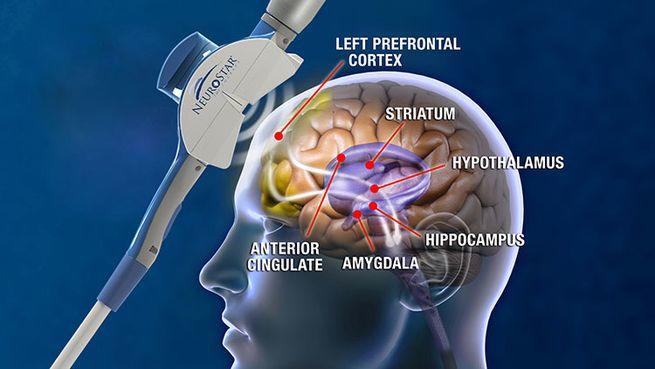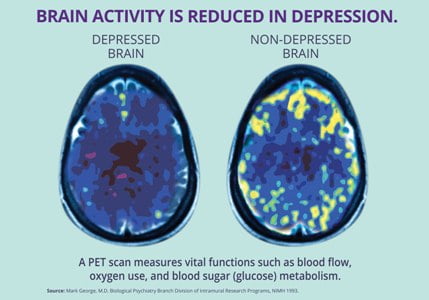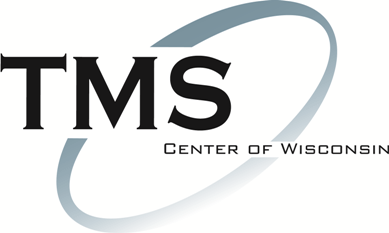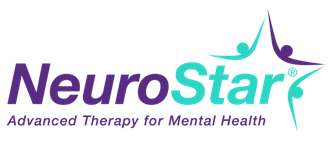About NeuroStar® TMS Therapy
NeuroStar uses transcranial magnetic stimulation (TMS) to target key areas of the brain that are underactive in people with depression. It is not ECT (electroconvulsive therapy).
While the exact cause of depression is not known, the leading scientific theory is that it is caused by an imbalance of the brain’s neurotransmitters, which are chemical messengers that send signals between brain cells.
What is NeuroStar Advanced Therapy (TMS)?
Treatment with NeuroStar Advanced Therapy is easy:
- Therapy sessions are conducted in your NeuroStar doctor’s office
- You can return to normal activities right away
- You are awake during treatment
- There are no negative effects on memory or sleep
- It’s covered by most health insurance plans, including Medicare and Tricare
With more than three million treatments delivered, this novel treatment approach to achieving remission is bringing new hope to people every day.
About NeuroStar® TMS Therapy
Here’s what you can expect from a NeuroStar Advanced Therapy (TMS) session:
Before Treatment
You’ll recline comfortably in the treatment chair. A small, curved magnetic coil will be positioned lightly on your head.
During Treatment
NeuroStar delivers focused magnetic stimulation directly to the target areas of the brain. You’ll hear a clicking sound and feel a tapping sensation on your head.
After Treatment
NeuroStar Advanced Therapy: Depending on your doctor’s recommendation, each treatment takes between 19 and 37 minutes.
You can resume normal activities immediately.
Because there are no effects on alertness or memory, you can drive yourself to and from treatment sessions.
In-office treatment with NeuroStar TMS Therapy typically takes 19-37 minutes and is administered 5 days a week for approximately 4-6 weeks.*


TMS Testimonials
After NeuroStar TMS Therapy, I am motivated and looking forward to the future.
If I could go back and talk to my depressed self, I would say ‘Do not hesitate. Get the NeuroStar TMS Therapy and make that change.
Now, I feel better than I have in years. I have my life back.
TMS Clinical Trials & Academic Studies
www.ncbi.nlm.nih.gov/pubmed/22689344
2. George MS, et al. (2010). Daily Left Prefrontal Transcranial Magnetic Stimulation Therapy for Major Depressive Disorder: A Sham-Controlled Randomized Trial. Arch Gen Psychiatry, 67(5):507-516. www.ncbi.nlm.nih.gov/pubmed/20439832
3. Dunner DL, et al. (2014). A Multisite, Naturalistic, Observational Study of Transcranial Magnetic Stimulation (TMS) for Patients with Pharmacoresistant Major Depressive Disorder: Durability of Benefit Over a 1-Year Follow-Up Period. J Clin Psychiatry. 75(12):1394-1401. www.ncbi.nlm.nih.gov/pubmed/25271871
4. O’Reardon JP, et al. (2007). Efficacy and Safety of Transcranial Magnetic Stimulation in the Acute Treatment of Major Depression: A Multisite Randomized Controlled Trial.
Biol Psychiatry, 62(11):1208-1216. www.ncbi.nlm.nih.gov/pubmed/17573044
Frequently Asked Questions
What is Transcranial Magnetic Stimulation??
Transcranial magnetic stimulation, often referred to as TMS is a noninvasive procedure that uses magnetic fields to stimulate nerve cells in the brain to improve symptoms of depression. TMS is typically used when antidepressant medications haven’t been effective, have ceased working, or as an alternative to medication.
How does TMS Therapy work?
TMS involves delivering magnetic pulses to specific parts of the brain.
How long is TMS treatment?
A typical initial course of treatment is about 19-37 minutes daily over 4-6 weeks.
Is TMS Therapy covered by my insurance?
A vast majority of commercial and Medicare plans have recognized the effectiveness of treating depression with TMS Therapy and now cover TMS as part of their plans.
Is TMS Therapy a good alternative for patients who cannot tolerate the side effects of antidepressant medications?
TMS does not circulate in the blood throughout the body, so it does not have side effects like weight gain, sexual dysfunction, nausea, dry mouth, sedation, etc. The most common side effects reported during clinical trials were headache and scalp discomfort —generally mild to moderate—occurring less frequently after the first week of treatment.
Is TMS Therapy like other alternative therapies that use magnets to treat some illnesses?
No. TMS Therapy involves a unique method of using pulsed magnetic fields for a therapeutic benefit.
The intensity of the magnetic field is similar to that of an MRI. These techniques differ radically from
the popular use of low intensity, static magnetic fields. Those products deliver weak and undirected
static fields that are not capable of activating brain cells. The activation and stimulation of brain cells
is a key part of why TMS is so effective.
Does it hurt?
Many patients experience side effects from their medication, increasing the chance that they will stop taking them. The most common side effect with NeuroStar is mild to moderate pain or discomfort at the treatment site. For most patients this subsides within the first week of treatment.
BOOK CONSULTATION
Contact Info
Give us a call to discuss your treatment options


